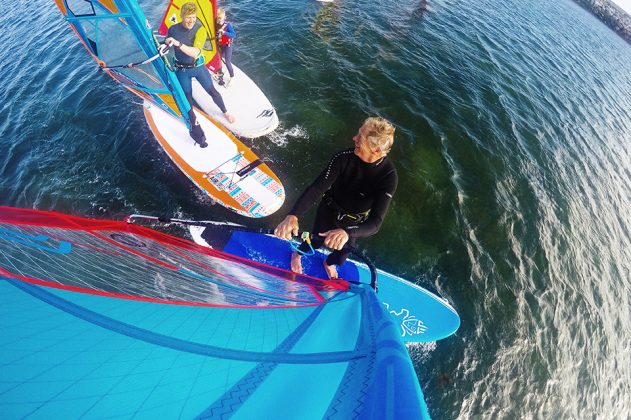“ PETER HART – FILLING IN THE GAPS ”
Words Peter Hart // Photos Hart Photography, Andy Stallman
Originally published within the July ’17 edition.
Some claim to have a preference for watching drying paint over messing around in light winds – and by so doing miss out on a guaranteed road to improvement. Peter Hart shows how to use a WindSUP to plug the gaping holes in your technique game – and have a bit of fun at the same time.
In the Green Room pub in Kerry, the conversation turned to WindSUPs. We were glowing from a gloriously fruitful day on them in light winds and small waves where all the group had light bulb moments with regards to the tactics and techniques of wave-riding. I chanted from my favourite hymn sheet about what a peerless teaching aid they are. In the past, I droned on, our ‘light wind alternatives,’ were going biking to the pub or staring miserably at the docile ocean – now, we just go windsurfing. Every day is good for something – and a 5 day course is so much better for the variety of experiences. Everyone nodded in polite agreement – until the second pint, when as usually happens, they lose all respect for me and start having their own opinions. The first to pipe up was Irish Ned who in his singing SE brogue told of his friend John whose demanding partner only grants him the very occasional 2 hour pass. So he’s never going to waste one of them twiddling around in a zephyr, when what he craves to preserve his sanity is a proper gale-driven, nostril-flaring, fully powered speed fix.
Better to be better
Coaches tend to see the world myopically believing that everyone who takes up windsurfing wants to improve all the time – when many surely are happy just going for a lovely sail, drinking in the environment and revelling in the ‘not-being-at-work-or-mending-the-fence’ release.
But actually I don’t buy that. Even if you took up golf just to get out of the house, you’d be happier hitting a clean, straight shot than shanking the ball through the clubhouse window. Speedy John would enjoy his escape session even more if his reaction to gusts and lulls was more calmly instinctive and less crisis management; if he went even faster and if for once he didn’t mess up his rig change and didn’t punctuate the end of every reach with an energy-sapping waterstart. All those improvements are tricky to master in strong winds – too much is happening too quickly.
Whichever level I’m coaching at, I note that the reason for most problems stems back to the shortage of a basic skill. And being short of an essential skill is NOT the sole preserve of the struggling intermediate. For example Miranda with her Vulcan and Geoffrey with his flare gybe are both struggling because they haven’t grasped the concept of releasing the nose before a move.
So coming up I’m going to identify the commonest missing skills and suggest which light wind exercises you can do to correct the situation.
But first – a few tips about your choice of WindSUP and rig.
Practice Tools
I’m not going to ramble on here. It’s a bit of minefield and Tris Best in his WindSUP testing feature picks an informed path through it. Just let me tell you how design, size, setup and rig choice size are relevant to the session ahead.
The whole point of this exercise is to encourage mobility of hands, feet, body and rig – get out of your box, stretch your limbs, lift your head and smell the roses. Force 2-4 is the ideal practice wind. We’re not looking to plane so by rigging a sail bigger than 5.7 you’re making life unnecessarily difficult … and missing the point. The more power you have to resist, the less you can move. The idea is not to plane but to get used to chucking the rig around, holding it in unusual positions and powering it up in different ways.
After his first session on his WindSUP in the waves, Charlie said: “the most confusing thing was that with no footstraps, I didn’t know where to put my feet.” That is the idea – a totally bare deck encourages you to feel the effect of foot positions on trim and manoeuvrability.
If yours has a daggerboard or optional central fin I suggest you lose them if your aim is to relate the exercises to planing moves. Without a dagger the board pivots and slides and to go upwind you have to use the upwind rail (edge) for resistance, in the same way you would on a small board. BUT … most inflatables, thanks to their thick rounded edges, are very hard to sail upwind without a dagger.
Length is important. The glory of a SUP is its long waterline, which gives you a beautiful sensation of gliding and heightens your awareness of longitudinal trim. If you go too short (sub 9’) you miss out on that. If you go super long (above 12’) they’re a mission to turn, especially in waves and even more especially if you’re light. As for the choice of hard or inflatable – both do the job – but for performance, especially in waves, hard ones with their thinner sharper rails (notably those under 10’ with ‘all-round’ in their title) do it a bit better.
Part 1 – Power Control – the instinctive resister
You’re probably familiar with the expression: “If your only tool is a hammer, everything looks like a nail.” The primary stance sinner is he or she (but mostly he), who buoyed by a degree of strength and a spirit of derring-do, enjoyed an accelerated journey into strong winds and planing. Their success (and success it is because they are loving this crazy new, skimming sensation) relies on having a lot of reserve power. By reserve power, I mean they have more than is strictly necessary to get them planing.
As a result, their relationship with the rig is primarily about resistance and pulling back against the force that is trying to pull them over. Resistance is their hammer. It’s a blunt instrument that leaves them:
• prone to oversheeting in gusty winds
• permanently in the back seat when entering speedy tacks and gybes
• very short of the subtle trimming skills needed to move down to smaller kit.
These first two exercises aim to completely change your power control instincts.
All in the front arm
‘Opening and closing the door’ is a useful analogy to help the beginner understand sheeting in and out. The front hand is the hinge; the back hand holds the door handle.
But ultimately the front arm should do an equal amount of power control. In fact the better you get, the more you use the front hand to manoeuvre and power the rig.
Drop the back hand back a metre, hold it still, head off on a reach and use the front arm to alter the sail angle – bending it to sheet out, extending it to sheet in.
This is a game-changer and introduces the concept of that you push rather than pull to increase power and speed. And on a similar note …
Sheet OUT to power up
The defensive resister lives by the maxim: “Pull harder go faster.” In the earliest stages the motto gets him to transmit enough force into the board to make it plane – but thereafter encourages the most destructive habit of all – over-sheeting.
Try this.
Across the wind, drop the back hand back and pull the boom in right over the centre-line. By over-sheeting, you stall the sail and kill much of the power. Then gradually open the sail again and feel it power up as it returns to its most efficient angle. Once again the idea is to reverse a reflex. Running into a gust, the instinct is to pull against – but in a gust, your apparent wind moves back (placing you on a broader reach) so you need to open the sail – and then gather it again as you accelerate. Duck gybes and top turns on waves are two more instances where you power up at the end of the move by opening the sail – where the instinct is to close it.
Power control is instantly easier with mobile hands.
Stance – the platform for success
Film a good sailor from the waist up coming towards you and it would be hard to tell if they were on or off the plane. In both instances the head is up looking over the front shoulder; they’re standing tall, hands back on the boom, arms parallel with the water, hips high. As you ease onto the plane, in terms of the way you stand, address and control the rig, nothing should change – but sadly it often does.
Take away the grunty counter-balance and many feel vulnerable and unsupported at which point they tense up and squat. The remedy is to think less about the rig and more about:
• Your own body shape – is it tall, aligned and balanced or crooked and out of shape?
• How you are balancing and where the pressure is on your feet.
• The effect of hand positions on your stance and trim.
Here are three exercises to alert you to your stance, balance and trim.
Find the tipping point and feel the feet.
Defensive planers sail on the heels. They over-commit to windward, bring the rig down over their heads in an “I’ll get my retaliation in first” attitude – their main objective being to avoid a catapult. Unthreatened by the light winds and small rig, the aim now must be to change your relationship with the rig from “don’t pull me over!” to: “please pull me along!”
The exercise in these unthreatening conditions is to find the edge of a catapult.
Stand tall, bear away a little and let the rig pull you more and more upright until you feel yourself toppling over – at the same time feel the pressure move from heels to toes. Then edge back and find the angle where the pressure is spread evenly across the foot and you can trim the board with both toe and heel pressure.
Do it lots, hooked in and out, until you reinterpret ‘edge of catapult’ for ‘position where the rig feels more comfortable and powerful.’
MULTIPLE CHOICE
Sailing a long WindSUP in various conditions can highlight the pros and cons of certain design features. The long straight edges so good for light wind speed and gliding, do not behave as you might like if you engage too much of them when gybing and especially not when turning on a wave face. Remember the chant – ‘forward for speed, back to turn.’
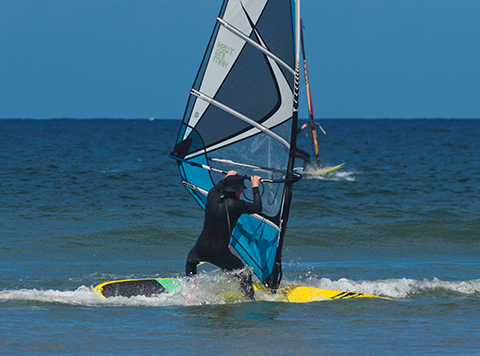
Those who forget to step back will find that a rail riding WindSUP is a pretty common sight in the waves. PHOTO Hart Photography
Hands matching feet
All that is good and bad about a stance stems from the hands. Their position on the boom will determine that of your feet.
We’re facing each other holding hands (stay with me) and lean back as if windsurfing. If I suddenly pull your right hand to the side, you will have to move your right foot out to maintain balance. So on board, if you move your front hand to the front of the boom, your front foot has to move forward to avoid a catapult.
Hence ‘front hand forward’ is the number one cause for slow planing and failure to move into the straps.
The exercise is to see how hand position affects your stance and trim.
Start with the hand forward. Gradually move them back – as you do so move the feet back so the hands are always covering the feet. Keep going until the front hand is only just in front of the balance point and note:
• How far much further back on the board you can stand without it heading up.
• How much more leverage you gain over the rig.
Pumping with one hand
Big loaded-up sails can completely de-sensitise you to the rights and wrongs of pumping. For many it’s a double-arm heave aimed to … well you’re not really sure but it makes the board jump about a bit. Take the load away and you quickly see how easy it is to stall the sail and kill your speed with a bad pump.
Inject some subtlety into the process by trying it with one hand. Place your back hand on the balance point of the boom (the spot where you can sail one handed) and pull gently to start with. What should happen, if the sail is set correctly, is that the rig closes, moves forward and then opens. You then pump again and repeat the process.
You learn that:
• pumping isn’t an in and out thrash but a subtle circular motion where you catch the wind and throw it out the back.
• You are the transmission. If you direct it through your toes right into the board’s balance point, you surge forward. If you stand forward or back of that point, you turn or push water and stop.
One of the greatest benefits of these light wind exercises is the discovery that the rig has a neutral gear.
Manoeuvres – be the dominator.
In a move that is survived rather than controlled, you’re a slave to the rig, hanging onto it for grim death knowing that if you release your vice like grip for a second, it flies away like a greyhound out of the trap. Hence in transitions you’ll shuffle the hands to the new side, sometimes holding both sides at the same time (common in the duck gybe), which in turn means you’re hugging the rig like a safety blanket and have no space to manoeuvre.
The next exercises are all about putting the rig into positions where it balances itself, plays dead, stops fighting you, so you can loosen the grip, sail one handed or even release the rig altogether and just relax.
Finding the balance Point
Sail on a reach, dip the mast to windward and sheet out until the sail starts to backwind. Play with those angles until it’s completely light in the hands and let go – one second at first and then longer and longer. You discover the rig has a neutral gear. It’s the failure to find neutral that leads to a dropped rig during tacks and gybes.
One handed tacks and gybes
See if you can complete a tack or do a gybe rig flip using just one hand. It’s only possible if you find the balance point as the rig is rotating. And as you sheet in on the new tack, you have to move the one hand back down the boom to sheet in.
The boomerang
It’s the trick where you callously throw the rig to the water and it miraculously blows back into your hands. It’s fun, impressive and liberating as you cast caution to the wind and show the rig who’s boss. On a very close reach, move the rig forward at the nose, release the front hand, let the mast swing away and then use the back hand to throw the clew down and forward.
If your timing is right, the act of throwing plus the fact that you’re heading into wind makes the wind hit the other side of the sail and push it back up. Nibble away at it. First let both hands go almost together then gradually let the mast swing further and further down before throwing the back hand. The benefits are two fold – you realise it’s OK to release the front hand first (a ‘no no’ when you were a newbie) which is key to learning moves like the duck gybe. And you learn that when you release the rig altogether, it doesn’t necessarily crash to the floor in an explosion of water and fibreglass.
“ The basic WindSUP question is: do you want to plane on it? If yes, then it will be flat rockered but won’t turn well either in waves or on the flat.An all-round WindSUP (hard) will have a continuous rocker which pushes water as you try to plane but which pivots beautifully. If you’re a good windsurfer with a quiver of planing boards, the latter option has to be the one. ”

A WindSUP session on an Irish wave clinic – people practising all the things they never would if they were powered up on small kit – like tacking between waves, sailing back-winded and thinking tactically.
PHOTO Hart Photography
RIG CONTROL from eccentric positions
Two issues ago I focused on balance and particularly how much more you’ll enjoy a session if you eliminate the unnecessary, energy-sapping falls – falls that could so easily have been saved if only you had more instant control of the rig in eccentric situations like when sailing clew first and back-winded.
Back-winded
‘Backwinded’ means sailing on the wrong side of the sail – that is to say facing the wind on the leeward side, pushing against it rather than pulling. Why you ask? Firstly a number of ‘old skool’ tricks (heli-tacks, up and downwind 360s etc.) and most ‘new skool’ stunts have a back-winded moment – but more importantly it gives you a powerful ‘get out of jail’ card, allowing you to generate force from different angles and save a manoeuvre. Losing balance after a transition, most instinctively pull on the boom to save themselves – but in some instances pushing is more effective. Across the wind in a light breeze, step around the mast as if tacking and take up your stance facing the wind on the new side. It’s all wrong. Smoke puffs from your ears as the brain blows many fuses. The sail pushes at you. You push back – don’t do that or it’ll push back harder.
Power control comes 80% from the front hand – and from tilting the rig over to windward to effectively hide part of the sail. The first aim, after a series of slams, is to keep leaning the rig over to the point where it stops fighting and you can balance it one handed (that hand will be near the front harness strap). And always hold it way at arms length, drop your shoulders forward over the boom and sail on your toes. Understand too that depowering comes from easing the rig towards the back and letting the clew rise (pulling IN the back hand). Powering up comes from easing the rig towards the nose and pushing on the back hand. We can talk about it as much as we like and it won’t help. You just have to get out, sail, steer up and down, note the changes in pressure and, through repetition, establish a few new neural pathways and learn to react instinctively. The road ahead is bumpy but worth getting wet for.
BACK-WINDED – not just a trick
Windsurfing is initially about pulling … and then it shouldn’t be. There are many reasons to stand on the wrong side of the sail and resist the power by pushing – sometimes just to show off, other times to give you another choice of counter-balance and save a fall. A new power control method is introduced – that of reducing power by using the front hand to tilt the rig to windward and hide it from the wind.
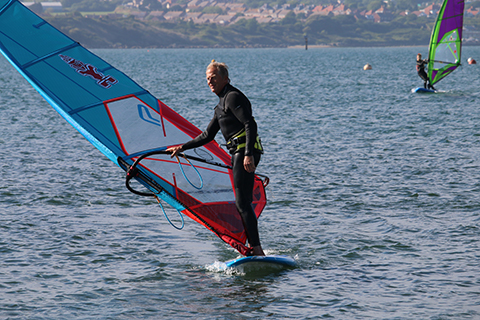
When back-winded, 80% of the power control comes from the front hand. The best training method is to try and sail with the back hand off – and feel for that leeward angle where the rig balances itself. From there, ease the rig forward to power up and back to ease off. PHOTO Andy Stallman

This exercise – the heli tack leading to upwind 360 with the feet well behind the mastfoot – is one of the first exercises on the new skool freestyle trail. It forces you to get bold, widen your cage of movement, soften the knees and lean right forward to control the nose. PHOTO Andy Stallman
LETTING GO
A stinking hangover from relentless powered up sailing is the point-blank refusal to relinquish the white-knuckle grip on the boom. They think it’s a tiger that, if released, will eat them. It’s not. It’s a pussy-cat that will play dead or even come back to you if you treat it with gentle respect. If you have the confidence to release one or both hands in manoeuvres, you create a lot more room as well as collecting admirers. The exercises below will teach you to give the rig its freedom.
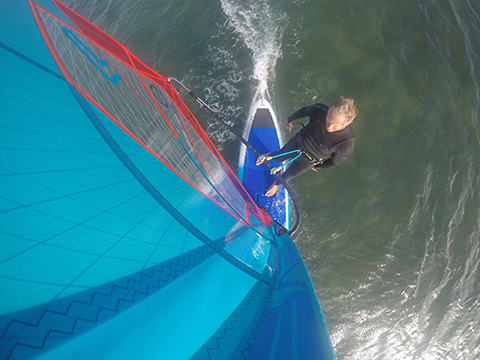
It’s the oldest pose in the book, but sailing hooked in no-handed remains the best way to sensitise yourself to the sail’s power point. It also teaches you that the main role of the arms when planing is to do the minor tweaks, not the pulling.. PHOTO Hart Photography
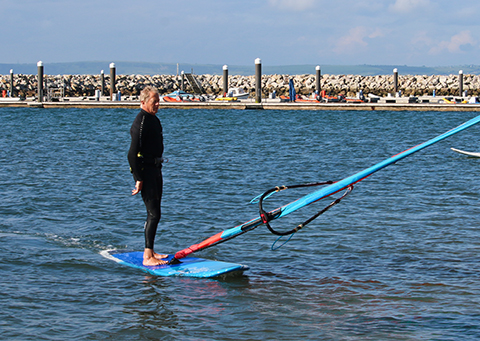
The boomerang – so impressive and yet instantly achievable. Throw the mast and then the clew into wind at the nose so the wind hits the other side and blows it back up – it sharpens your wind awareness and introduces the notion of back-winding. PHOTO Andy Stallman
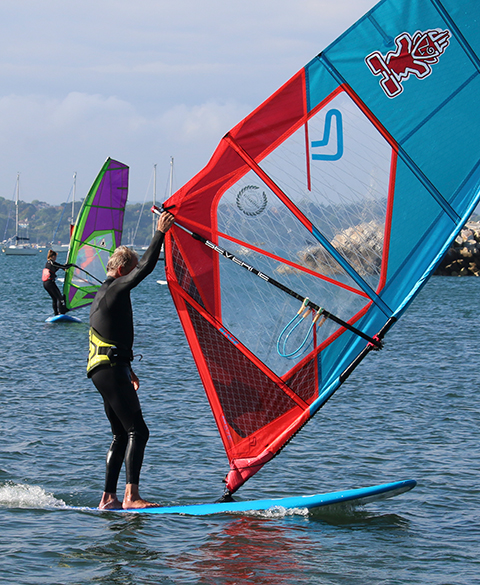
The light wind duck gybe showing the one element missing from many attempts – and that is to get the front hand right to the end of the boom, from where you have space and a clear view of the new side – only possible if you release the sail completely. PHOTO Andy Stallman
Clew First
If I had a cent for every time I’d seen someone make it round a gybe as far as clew first and then blow it, I’d be writing this from Monaco. Being able to sail, steer and respond to gusts clew first is the biggest escape card of all and will save you thousands of waterstarting or uphauling calories.
A couple of things make it a bit of a challenge.
With the sail reversed, the centre of effort lies more over the back of the board and so makes it head up.
Sailing across or upwind, the unsupported leech is the leading edge (the edge the wind hits first) so the sail feels ‘tuggy’ and unstable.
There’s the first tip – don’t try and sail upwind clew first. It’s much easier downwind because the mast is then the leading edge.
The first tip is to do it … lots. Come out of a gybe, change feet but don’t flip the rig – just keep sailing and respond to the unusual pressures.
Like back-winded sailing, the normal sheeting in and out roles are reversed. You pull in the back hand to sheet out and extend it to power up. All you’re doing is hiding the sail from or exposing more area to the wind.
Bearing away is trickier. Step the front foot well forward of the mastfoot and at the same time open the clew hand; direct that pressure through the front foot and push the nose off the wind. In a breeze it takes a bit of grunt.
People drop the rig when they flip it from the clew first position because they release it too close to the wind at which point the leech is really tugging and the thing gets ripped from their hands. The sequence is to bear away, depower by pulling in the clew hand and then bring the rig upright to its balance point so you can centre yourself, stand straight, pressure the heels and anticipate the whip forward – and then release it.
If you release a rig with your weight on the toes and the mast tilted to leeward, you’re only going one way – down face forward.
“ On the SUP you have time to clock the angle of your sail to the wind – and you realise that powering up comes from presenting the maximum area to the wind – which you do from pushing OR pulling.. ”
GYBE EXIT in slow motion
The pic doesn’t look startling, but it’s the position so many fail to adopt as they carve out of a gybe – hips pointing into the turn, shoulders facing out to power up the sail clew first. In light winds, you do a non planing gybe and try and exit without changing rig or feet – the muscles used and the strains experienced are the same as at 30 mph.
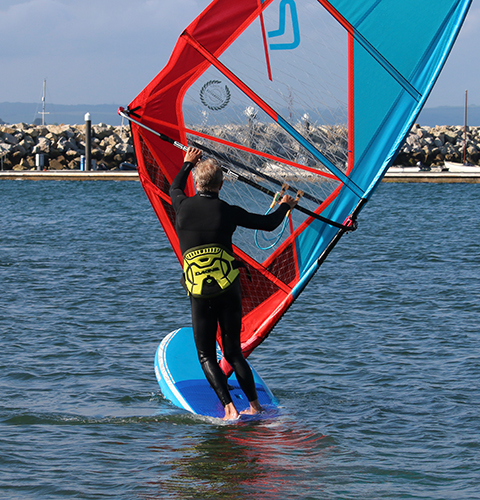
Non planing switch foot and clew first – a key position in so many moves. PHOTO Andy Stallman
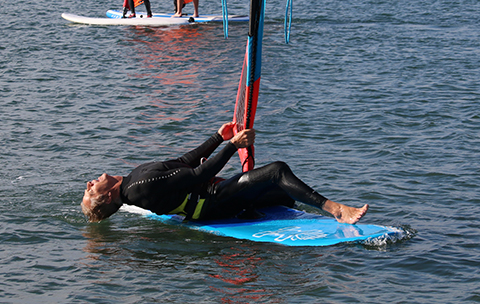
And while you’re down there – why not indulge yourself with the number one, pre-millennium freestyle trick – the head dip! PHOTO Andy Stallman
Toes down, windward edge up
Under rotation and that horrible feeling of prematurely nose-diving and slamming, is so often down to board angle. If you hesitate or get momentarily defensive, you fall back and weight the heels. As the windward edge drops on take off, the wind hits the deck and drives the board straight back down. You have to take off from your toes. For a start you get more spring – but more importantly, you lift the windward edge, present the underside to the wind, which then drives the nose off downwind. The toes must stay down all the way round.
Here’s the sequence.
Sheet in as you approach the wave, sheet out as you climb the face to release the nose and at the same time drop the toes.
Wait for the wind to blow the nose downwind before picking up the tail and sheeting in again (by straightening the front arm) to power up and rotate.
MORE ‘VROOM’ to your MOVES
A carve gybe where the board seems to ride around a smooth but gentle track on rails elicits a gentle ripple of appreciation. But the one that turns heads and is greeted with a chorus of ‘whoops’ has a calm entry followed by a dynamic gouge where suddenly the whole rail buries and throws up a curtain of spray. The turn is done and dusted in a couple of seconds of raw explosiveness before the sailor returns to a state of calm nonchalance.
That dynamism comes from sheeting in with a growl and directing that power into exactly the right part of the rail. And it’s something that’s equally powerful off the plane. Here are the elements to practise.
“ The length of the WindSUP alerts many to the notion of fore aft trim and how crucial it is to both speed and ease of turning. ”
The ever mobile back hand
If you don’t move the back hand back down the boom, you limit how hard you can sheet in. It’s by sheeting in that you control the nose, bury the rail and create the explosive power to rise up. I understand the issue. With so much else going on, it’s all too easy to forget to move the back hand.
Get used to it with the WindSUP.
Initially hold a straight line.
Without pushing or pulling, you note that by moving the hand back you immediately sheet in; and as you move it forward again, the sail automatically opens. It’s a less tiring and more efficient way to change the sail angle and instils good habits. The next step is to introduce it into a gybe.
Releasing the nose, reducing the rail.
A common sight is that of someone light wind gybing a SUP and following the turning circle of a super-tanker. No matter how much they scoop the rig and try to steer, the board just bumbles off downwind.
Two things are working against them.
• As they turn downwind the head wind cancels out the real wind and they have no turning force in the sail.
• The long rails of the SUP are gripping the water and resisting turning.
The skill to crack is a ‘spinny’ gybe highlighting 3 key elements.
No bear Away. Start the gybe close to the wind and pivot it within its own length. By NOT bearing away, the rig stays powered.
Release the Nose. Start the gybe by sheeting out and stepping back to release the nose, and get the front section of rail out of the water.
Back hand back. Drop the back hand right back on the boom to give you the leverage to properly sheet in (see above)
With the nose out of the water, you sheet in by stretching out the front arm to
windward and pulling on the back hand. Direct the power into the back foot, at the same time dropping the hips to the inside. If you make yourself the centre of the circle, the board pivots around you.
By changing your position on the board, you get a feel for the rocker-line. Move back so far and the board still doesn’t pivot. Move back an inch more and suddenly it releases. It’s the same with a short board on the plane except the fore and aft movements are more subtle. A board is so much more than just a platform and this light wind exercise alerts you to how crucial your position on the board is to both easy gliding and turning.
Summer is here. That should mean light, warm breezes. Get out there and twiddle. And take joy from the knowledge that if you do tool up for gentle WindSUP practice, a stormy August is guaranteed.
More technique golden nuggets from Harty next month. His website www.peter-hart.com reveals dates and details of his clinics and DVDs – and catch up on latest news on his Peter Hart Masterclass Facebook page.


